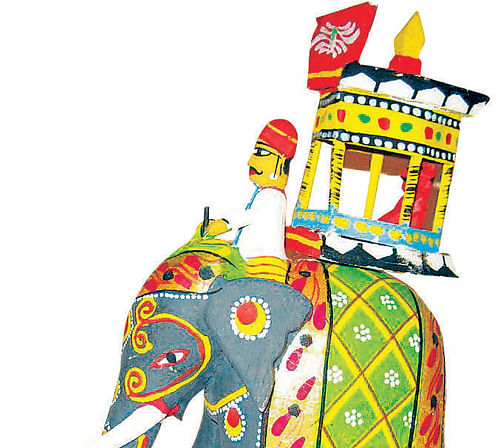
A better way to understand the richness of Indian mythology is to look at the fascinating Kondapalli toys of Andhra Pradesh.
Not many art buffs in India are aware about the hamlet of Kondapalli (about 16 km away from Vijayawada, in Andhra Pradesh) that has highly skilled craftsmen carving an impressive variety of wooden toys that come in a riot of colours using the South Indian style of architecture.
The craftsmen of Kondapalli are well-versed on the subjects of Indian mythologies, and themes from Dashavatara, Hitopadesha and the life of Lord Krishna are depicted using toys.
The craftsmen of Kondapalli, who belong to the Aryakhastriya community, have chosen sculpting wooden toys as their profession since long.
One can find a mention of this community in Brahmanda Purana, and these artisans believe that their ancestors crafted the sculptures of Nandi and Garuda in many shrines in Andhra Pradesh.
The craftsmen toil day and night to work on a theme at home, and the entire family is involved in the process of making toys.
Snippets from rural life and folklore, and animals, dominate the themes. One can come across colourful peacocks, bullock carts, parrots, elephants etc carved on wood. Toys representing Lord Krishna playing the flute rule the roost. They are a source of learning for children and create a unique connection with the world. Kondapalli toys make unique home decor items. They are priced from Rs 50 to Rs 5,000.
The craftsmen look into every aspect of toy-making, including the appearance of the figures. They are crafted from soft puniki wood.
The wood is treated to a slow heating process to dry its moisture content. The limbs of the toys are carved separately and later joined to the body. The essential carving tools are axe, chisel, hammer and drill.
The glue used to join the parts is made of tamarind paste. The paint brush comprises goat’s hair. In the bygone days, natural colours from stones, herbs, roots and gums were used, while today, both water colours and oil paints are prevalent. The use of chemicals is avoided.
Kondapalli craftsmen once received the patronage of local rulers, but the art now is on decline due to the advancement of technology.
A number of craftsmen have done away with their profession. The government has now taken up steps to revive this art form.